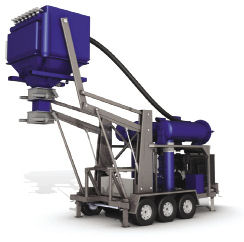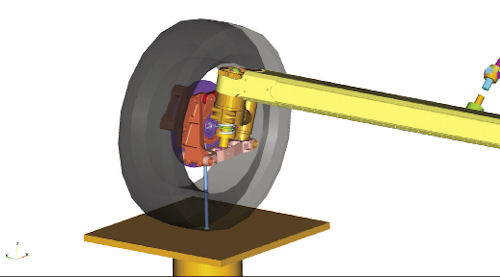Latest News
March 1, 2013
When you’re designing the next generation of a product, there’s an unquestionable requirement for all engineering disciplines and skill sets to be on deck. But what happens when you’re a small, modestly funded upstart with an extremely limited on-board engineering talent pool?
If you are Edison2—or any of a growing number of startups and even larger manufacturing companies—the answer lies not in growing internal staff exponentially, but rather, in partnering with outside consultants, engineering services firms, vendors or product development specialists as a way to tap into collective domain expertise in a more cost-efficient and productive manner.
 Leveraging Product Data Management (PDM) tools and concurrent engineering practices, Inertia Engineering & Design facilitated the design of this industrial vacuum trailer for a client in less than eight weeks—-nearly half the timeframe required by traditional product development methods. |
In the case of Edison2, which took home the top $5 million prize in the 2010 Progressive Insurance Automotive X-Prize competition for its Very Light Car (VLC), the company is now knee-deep in development on the follow-up VLC 4.0. This is a completely new model that employs some of the same architecture and fuel efficiency features of its predecessor, but it is being designed with an eye toward commercial production. Thus, it must address standard regulatory requirements as well as safety, comfort and handling features.
Given the scope of the work involved, Edison2 made a conscious decision to enlist a third-party partner in the development effort “in this case, Altair ProductDesign “rather than taking the time to build out its internal expertise or invest in costly simulation software. So says Brad Jaeger, vice president of engineering and operations at Edison2.
“We have a big-picture problem to solve, and we need engineers that can understand the problem holistically and design what amounts to a proof of concept,” he explains. With simulation capabilities and optimization at the forefront of this next-generation product development effort, Jaeger says it made far more sense to tap into Altair ProductDesign’s deep bench of simulation talent, as well to leverage Altair’s knowledge of applying its own simulation tool, HyperWorks, to a range of cross-industry engineering problems.
“We can take their expertise and knowledge, and the tools that are available to them, and get a much quicker turnaround in terms of getting results from simulation,” Jaeger says. “It’s also a much better price point, from our perspective.”
Jaeger points out that there is no need for Edison2, which has 12 employees (only three of whom are engineers), to purchase any software or hardware. Nor does Edison2 need to invest the time it would take for an individual engineer to get up to speed.
“It’s hard to dedicate a few months for one engineer to get up to speed with the ]simulation] software, then actually start cranking out results,” he adds. “This lets us avoid that ramp-up time and cost.”
Specialty Requirements Drive Demand
Many companies, big and small, across all industries are finding themselves in a similar boat. Continuing economic pressures means reduced resources for many shops, and like Edison2, it can be cheaper for a firm to tap outside engineering reserves on an as-needed basis “or even as a long-term engagement compared with building out their internal engineering bench.
Scarcity of specialized engineering talent is another factor driving companies to look for outside help: “The United States isn’t graduating enough engineers, and there are a lot of jobs that can’t be filled because the expertise isn’t there,” notes Ken Amann, executive consultant with CIMdata, a PLM consultancy and research firm. “It also makes it difficult for companies to keep and maintain some of the skill sets they need.”
Specifically, increasing demand for simulation and optimization services, coupled with intelligence around the use of new materials, particularly composites, are specialty areas that are in hot demand. Another big gap in most companies’ internal engineering knowledgebase is deep experience in software and electronics development “both critical aspects of today’s increasingly multidisciplinary products, whether they be jumbo jetliners or mainstream consumer appliances.
 Edison2 turned to Altair ProductDesign for engineering services. Image courtesy of Edison2. |
“One of the reasons for accelerated demand is the increased product complexity, especially that surrounding software and electronics, which is outside the domain of the expertise in most companies,” notes Joe Barkai, research vice president at IDC Manufacturing Insights, a market research firm. “Companies have issues maintaining enough talent with the expertise at the right cost structure.”
Boston Engineering, which provides everything from new product development to test and measurement to manufacturing automation services, says the complexities of designing mechatronics products has helped fuel demand for its services, according to Mark Smithers, the company’s vice president and COO. Unlike some engineering services firms, which focus on mechanical, electrical or software services (or even some combination thereof), Boston Engineering takes a systems approach to engineering. Smithers says the company infuses that discipline in both its processes and its strategies, which greatly aids in the design and development of complex mechatronics products.
As simulation and optimization play a larger role in product development, particularly early on in the cycle, companies are looking to augment their in-house resources with experts familiar with specific CAE tools, and with consultants who understand how to apply physics to solve the engineering problem at hand.
Carlo Poloni, CEO of ESTECO, the maker of the modeFRONTIER multidisciplinary simulation and optimization software, says he is definitely seeing an uptick in demand for consulting services from companies who want to take full advantage of the product, and see optimization as delivering a competitive edge.
“The design of new competitive products require sophisticated engineering considerations ]and software tools] that frequently are not even present in the corporation developing the product,” he continues. “For this reason, high-level engineering consulting is required, as the product development cycle cannot wait for internal knowledge to grow. It is frequently far more efficient to ask experts to address the engineering problem and build an automated analysis process when the issue is a reoccurring one. It’s both time-to-market and solution quality that lead companies to cultivate outside partners.”
Help applying simulation and optimization software to both the suspension and safety aspects of the VLC 4.0 is part of what drove Edison2 to work with Altair ProductDesign, Jaeger says. It’s also behind an increasing number of engagements for Inertia Engineering + Design Inc., a product development and engineering services company “which is growing, on average, about 30% year-over-year, according to President Ray Minato.
IE+E’s depth of knowledge around simulation and materials, coupled with its well codified development processes, makes it well positioned to provide soup-to-nuts development services, Minato says. Such services range from vetting product requirements all the way through concept design, testing and even oversight for manufacturing and production.
“It just makes sense to take a whole view of a situation,” Minato explains. “When you’re doing just a portion of it, there are inefficiencies, and things might get lost.”
Making Relationships Work
Whether the engagement is a long-term outsourcing relationship or a pay-by-pound simulation project, IE+D adheres to number of common processes “and leverages a variety of collaboration tools to ensure the partnership is a success. In addition to employing SolidWorks product data management (PDM) as its backbone for storing and collaborating on all project-related design data, the company has honed quality processes and engineering workflows over the years that drive engineering efficiencies and keep all of the project stakeholders on the same page, Minato says.
New collaborative design capabilities, generic collaboration platforms, videoconferencing tools like Skype and WebEx, and even a new generation of social design tools are all helping facilitate the requisite levels of communication that ensure profitable outsourcing partnerships. This is especially helpful when the arrangement is conducted primarily off-site. Minato notes that the biggest challenge lies in managing expectations, which is where robust tools and formal communications processes come into play.
 Inertia Engineering & Design was tapped by truck body manufacturer Unicell Ltd. to serve as the project lead on the QuickSider battery-powered urban delivery vehicle. |
“The approach we take is to tell our clients the story of what we’re doing “not just the technical details, but what we know, what we don’t know, the pros and cons of ideas, the recommended solutions,” he explains. Design reviews are provided on at least a weekly basis, and “at the end of the project, a client might have 40 to 50 PowerPoint files with all the learning in there so they can understand it.
“By including them in the process, they are involved in the decision-making, and we are seeking agreement at every step, always reiterating the risks,” he explains.
In addition to tools and open and regular communications, experts agree that it’s critical to establish clear roles, including who is responsible for what, as well as to formalize contractual agreements to specify ownership of intellectual property. There should be clear levels of protection included, as well as remedies in case of a problem. It’s also important for the client to keep skin in the game, so to speak, and not abdicate all engineering responsibilities to an outside party.
“You have to be smart and sophisticated about what you have to own and what you outsource,” says IDC’s Barkai. “It’s striking that right balance between innovation and reuse, and what you keep in-house and what you outsource.”
Beth Stackpole is a contributing editor to DE. You can reach her at [email protected].
MORE INFO
Subscribe to our FREE magazine, FREE email newsletters or both!
Latest News
About the Author
Beth Stackpole is a contributing editor to Digital Engineering. Send e-mail about this article to [email protected].
Follow DE





